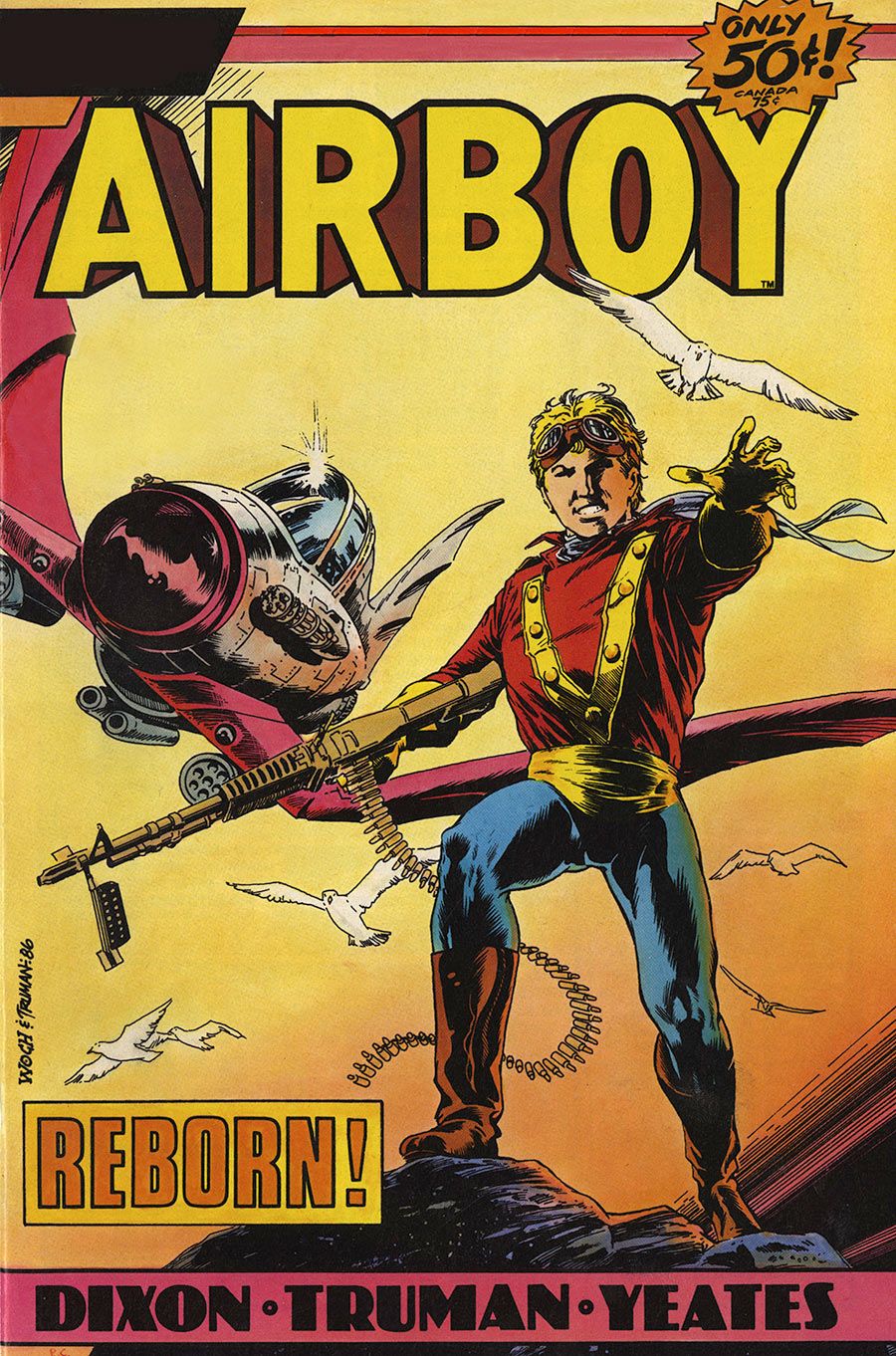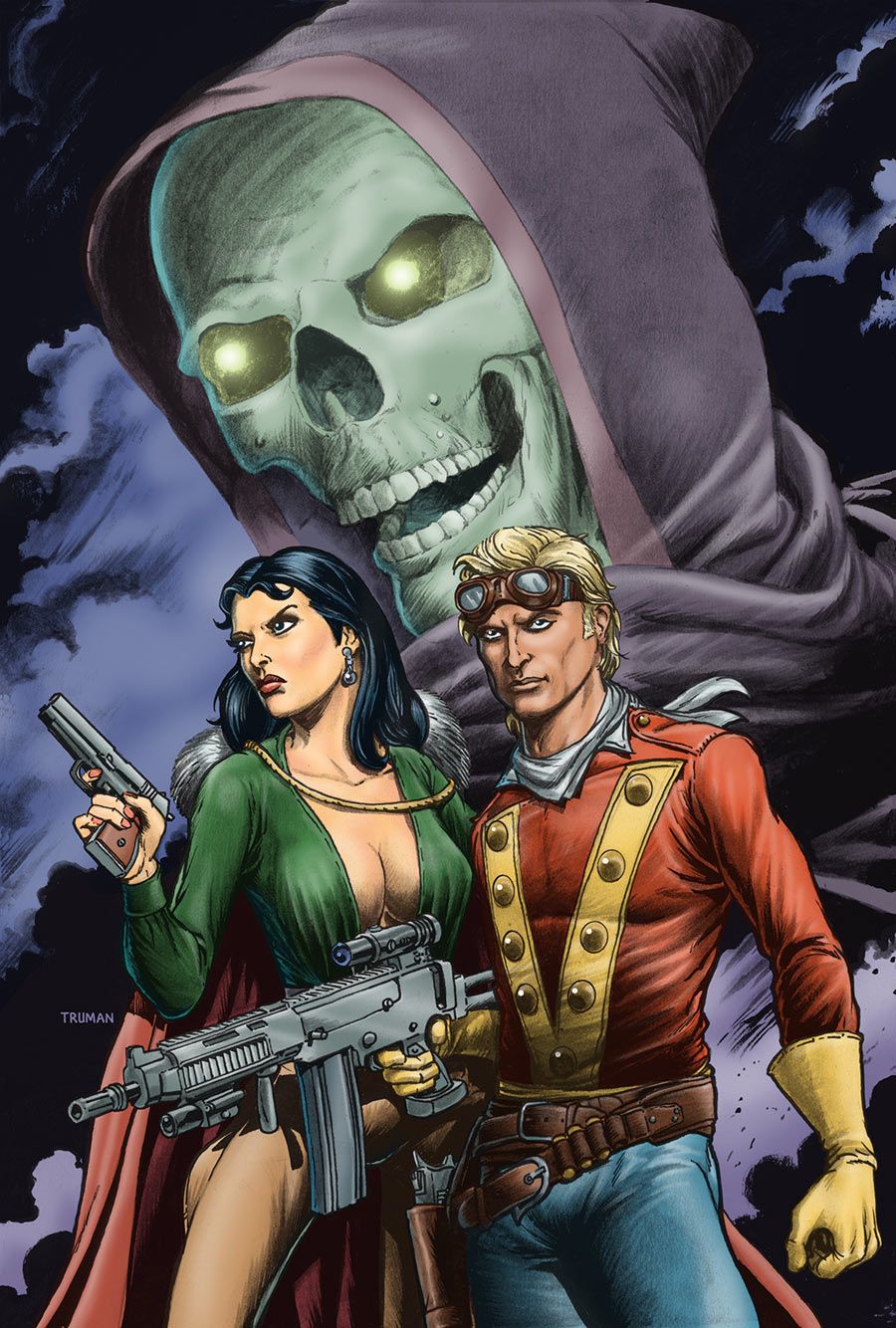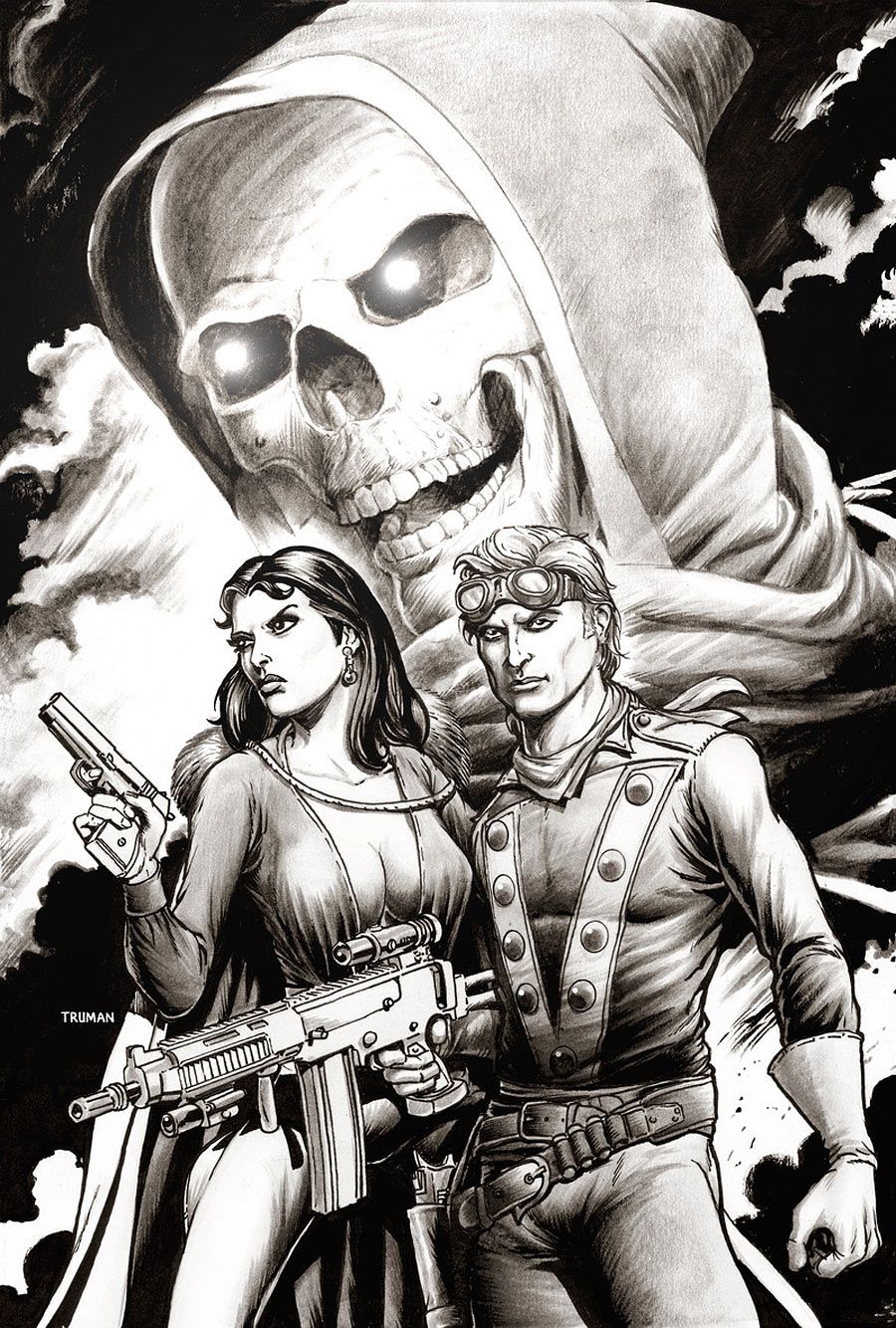While Chuck Dixon and Tim Truman are mainly known for separate pieces of work -- the former being a major contributor to DC Comics' 1990s Batman titles and the latter reinventing Hawkman for the same publisher in the late '80s/early '90s -- the two also collaborated together on the 1980's revival of "Airboy."
Published by Eclipse from 1986-89, the pair's reimagining of the classic Golden Age hero was met with enthusiasm from fans and critics alike. Now, in 2014, IDW Publishing is set to release collections of the entire series, with the first book arriving in March.
CBR News spoke with the creators about their memories of working on the series, the excitement they have over seeing it return to print and their reactions to the news that Airboy is once again set to take flight on new adventures, this time via an offbeat Image Comics series helmed by James robinson and Greg Hinkle.
CBR News: How did each of you end up involved in "Airboy?"
Chuck Dixon: Well, Tim brought me on board when Eclipse offered it to him. Tim was packaging his own titles through 4 Winds. I was a newbie but eager and already a big fan of Airboy. Tim sold Cat and Dean on me. I think my enthusiasm played a part.
Timothy Truman: If I remember correctly, I was approached by Dean Mullaney and Cat Yronwode when they were thinking about launching a revamped version of the old Hillman character. My comic, "Scout," was the most popular book they were publishing at the time, and we had always worked really well together. They wanted me to draw an issue or two and then edit the book after helping put a permanent team together to produce a continuing series. It seemed a bit daunting at the time -- they had this innovative idea of producing a weekly book, which meant the deadlines would be pretty intense. Also, I was writing, penciling & inking interiors and covers for the monthly "Scout" comic -- an unbelievable amount of work, and I'd never missed a deadline.
Despite those concerns, I agreed to take it on -- I'd read about "Airboy" in Steranko's "History of Comics" and always thought he was a really fascinating character. Also, the whole thing happened to coincide with a notion that had been roiling around in my little brain for a while -- to put together a group of creators to package books for comics companies, inspired by folks who'd set up similar companies in the 1940s and '50s, like the Simon & Kirby and Eisner & Iger shops. However, in our case, I didn't want to take a cut off the top -- everybody would get paid full rate for their work. I wanted our packaging outfit to act as a sort of artist and writers club -- the "go to" organization that would put together publishers and really talented, dependable folks who were looking for regular gigs
RELATED: James Robinson is Up to No Good with "Airboy"
I'd met Chuck Dixon at a Chicago convention, and we'd hit it off like old war buddies. I'd loved his work on the comic "Evangeline." We became pretty close and started corresponding really regularly. Chuck was a militaria expert and one of the best old-style adventure writers in the business. Plus he was notorious for being a writing machine and never missing a deadline. So he was one of the first writers I thought of when Dean and Cat approached me.
Chuck and I had a bunch of friends in the business and had also been keeping in touch with various aspiring artists we were meeting at cons and whose work had really impressed us. As a result, Chuck and I threw ourselves into putting something together, handling stuff 50-50. We started calling folks, and things just seemed to fall together pretty naturally. We called the outfit 4Winds Publishing and created an imprint via Eclipse, producing "Airboy" and a bunch of other really cool projects.
Had you read any of the original series from years earlier? What about the concept appealed to you?
Dixon: I was introduced to "Airboy" by the Steranko comics history. I found a Xerox reprint edition of the first issue of "Air-Fighter Comics" at a con in the '70s. That led me to but some of the original comics from the '40s and '50s. "Airboy" was a big seller for Hillman, and there were lots of copies published. I could pick up copies for under five bucks, most of the time.
Truman: I think Chuck had managed to collect the original series, but believe it or not, I'd never actually read any of the old Hillman "Airboy" stuff! They were impossible to find in West Virginia when I was growing up, or in any of the comic shops I used to go to in New Jersey while attending the Joe Kubert School. My fascination for the character initially came from reading and re-reading the chapter about him in Steranko's "History of Comics." I thought he sounded amazing, and the covers and pieces of art Steranko included in his book were really mind-blowing. However, after Cat and Dean approached me about doing something, they sent me a stack of photocopies of old issues from their collection, and I just ate the material up. I think Chuck might have let me look at a few issues from his collection as well, once we started brainstorming.
How much freedom did you have in developing and crafting the series?
Dixon: Total, from my memory.
Truman: Almost total, as I recall. Cat and Dean had a few stipulations, of course. One that I remember was that they were adamant that the stories be present-day, which suited us fine. I think Cat thought it important to keep Birdie, the bat-winged plane, and after a little thought, I climbed on board with that idea. I think Chuck might have been reluctant about that at first, but soon saw it was the thing to do. We had a lot of fun with Birdie.
Cat and Dean and I had been working together for a long time at that point, and they trusted me enough to be willing just give us pretty much full rein and to let us cut loose. They knew that was the way I worked best and that's the way they'd they'd get my full enthusiasm. I try not to be a prima donna, but I don't like too many shackles put on me when I'm trying to come up with a concept, either in my comics work or the illustration work that I do. If it becomes just a job, I lose interest really quick. Chuck was pretty much the same way, at the time. Just give us the sandbox and stand back -- stuff is going to start to fly and interesting things are going to get done.
How did the two of you work together on the series?
Dixon: It was pretty organic. But Tim's instincts to keep the comic true to its roots were strong. He insisted we only update it so much. I was all for ditching Birdy, but Tim thought Birdy was the key to the series and more than just a conveyance. He was right. Birdy is like Trigger or Silver to Airboy. Keeping Birdy intact, but converted to jet power, kept the funky tone of the original and made it a perfect fit for Eclipse.
Truman: It was a blast, at least during the first year or so, when I was managing to maintain any vestige of sanity. Chuck would drive up to my house in Lancaster and we'd do these marathon gab-fest concept sessions, throwing stuff out there and making notes. Then Chuck would go home, type stuff up, and -- in those days, before email -- FedEx or mail drafts of pitches and story outlines to me. As far as various concepts go, I'd be hard-pressed to say who came up with what. We were a real idea factory.
Once we started work, Chuck would call me on the phone and we'd talk out plot ideas. I tried to give him a lot of liberty as far as plotting went. If he mentioned something in his plotline that struck the flint of some new idea in my head, I'd pitch it at him. If I had an idea for a plotline, like for the German werewolf character we used in an arc or two, I'd throw it out to him to see if he could use it. We were a great team in that regard -- a lot of mutual respect for each other's work and ideas. After that, I'd go back to working on "Scout" or inking one of Stan Woch's covers. Chuck would type up the finished script, mail it to me, I'd give it a once-over, maybe edit a few bits of dialog here and there. You really didn't have to do much with Chuck's scripts, though. It was all there. After that, the scripts went to Stan Woch to draw. Stan would send me photocopies of the art and, unless it was a cover I was inking, FedEx the originals directly to Eclipse, who were on the opposite coast. It was always great to see Stan's work come in. One of the most maddening aspects of working with Woch was the fact that he was always putting down his own work. We'd look at the stuff he was doing and our jaws would just hang open in awe. "Geez, man, what the heck are you talking about??" Man, it was amazing stuff. So well drawn. I felt like throwing away my pencils every time he'd turn in an issue.
After a year or two, I must say that the pace really got to me, though. Like I said, I was plotting, writing and drawing full issues of "Scout" every month. I was editing "Airboy," "Sky Wolf" and the 4Winds stuff for Eclipse, as well as planning new projects, lining up cover artists, coordinating getting all the work in on time, answering phones, and at the same time trying to find time to be a good husband to my wife Beth and a good daddy to our children Ben and Emily, who were preschoolers at the time. I think back on that time, and don't know how I managed to get it all done for as long as I did. I don't mean to sound like a whiner, but I got to be a pretty disagreeable ogre, and the artwork I was doing on Scout was really suffering. So I decided to give it up. Cat took over the editing, and I moved on to other stuff.
Chuck, you posted some pages on your website a while back from what would have been issue #51 of the series. I'm curious where you wanted to go with the series and what other stories you wanted to tell. I know you've revisited the character a few times since it ended.
Dixon: There was a kind of sketched out idea that Davy would find himself wiped of all memories and lost on the African veldt where he would encounter a kind of white supremacist Tarzan character. It was the White Lion, a guy who appeared in the Golden Age "reprints" that appeared in the back of "Strike!" Valkyrie and Skywolf would have their own adventures while they searched the world looking for Davy.
Tim, you're illustrating the covers for the IDW collections. I'm curious -- how does it feel to revisit the character?
Truman: It was pretty darned cool. My own work has changed and improved so much since those days. I was really churning it out in the '80s and '90s, full throttle, dive bomb mode. So it was great to be able to kick back and spend a few days on the covers I've done, put more care and craftsmanship into them and do them as tributes to guys like Stan Woch and Paul Gulacy, whose work on the series just slayed me at the time.
As far as you know, are we going to see the entirety of the Eclipse series collected?
Dixon: There are three volumes planned, as I understand. The specials, one-shots and miniseries will all be reprinted.
Truman: Yep. I sent you the art for the second cover which I just completed a few weeks ago before leaving for CalCon in Yorba Linda, CA. I didn't have time to paint the cover like I did the first one, but Lovern Kindzierski did a great job with the digital coloring.
Do you have a favorite memory of the series or a favorite character or scene?
Dixon: It was all fun. Even behind the scenes, with a Barry Goldwater conservative writer working with an editor who was a self-avowed communist.
Truman: Well, if you mean me, an unrepentant lefty, anyway. But I'm hardly that far left. Cat? Well, maybe. Whatever the case, the different viewpoints made a good mix. As far as things I remember about those days, putting together the 4Winds Group is something I'm really proud of. Nothing like it had been done for a long time. I think that it subsequently influenced the way other folks approached the business. Plus, we did some books I'm really, really proud of -- the various "Airboy" books, "Winterworld," "Hotpsur" with John Ostrander, and the like. And the people we worked with were fantastic.
I got to work with Paul Gulacy, one of my biggest influences, and we became good friends. I also got to ask George Evans to do a couple of pieces for us, which was fantastic. George lived really close by, and he hadn't lost any of his chops -- he was just as incredible at 70 as he'd been when he was doing the EC books in the '50s. Another hallmark was the chance rediscovery of a golden Age artist named Vern Hinkle, whom I found out was living in a retirement community nearby. Vern did his last comic work for us. That was pretty cool.
However, as far as the comic itself goes, one bit that I'm most fond of can be seen on page 1 of the first "Airboy" comic we did. There's a picture of a girl on a table, and it's signed, "With Love from Penny," or something like that. We didn't really come out and say it, but Chuck and I knew that the girl in the picture was Penny King from the old "Sky King" TV series! She's married Davy Nelson Sr. and was the mother of our Airboy! Pretty cool.The old "Sky King" fans out there who recognized our little tip-of-the-hat really got a kick out of that. There were a few little things like that in there, as I recall -- stuff that we'd throw in and wait for other total fan-geeks to catch.
It was announced at the recent Image Expo that James Robinson and artist Greg Hinkle will be releasing a new "Airboy" series that's, well, about them trying to relaunch "Airboy." Or something like that. Do you have any advice for them or something that you hope to see in their series?
Dixon: Well, I know [Robinson's] an "Airboy" fan. His movie, "Comic Book Villains," opens with a conversation about the Eclipse series. Some fans in a comic shop discuss how f***ed up the whole Valkyrie/Davy Jr relationship is.
Truman: Best of luck to him. Sounds really interesting, and I hope he has as much fun as we did. All told, while I love the original character and certainly enjoyed our revamp of the Hillman characters, "Airboy" was a work-for-hire effort. It doesn't pay to get too paternalistic about characters on projects like that. I save it for creator-owned stuff that I do. As a reader and fan, I'll look forward to seeing what he does with the character, just like I enjoyed seeing what Ben Dunn and Chuck did with the old Hillman "Airboy" a few years back.
You're both very busy with different projects these days. What are you working on now?
Dixon: I have a lot of projects I can't talk about yet, but I have a prose novel series called "Bad Times," available through Amazon. It's time travel, shoot-em-up adventure stuff.
Truman: Right now, I'm putting together a pitch for a new "Scout" series, "Scout: Marauder," that a publisher asked fo. It's pretty exciting. People have asked for it for years, and the time seemed right. My son, Ben, who scripted the "A Man Named Hawken" series we did together a year or so ago, is co-plotting and scripting "Scout: Marauder." It's been great to revisit Scout's world, and hopefully we'll have some news on that soon.
I just finished up writing "King Conan the Conqueror" for Dark Horse, and Issue 1 ships this month. Other than that, I've been doing a lot of paintings for limited edition hardcovers from Subterranean press and a lot of CD covers and special projects for rock bands, including a huge painting for a limited edition lithograph for Grateful Dead Productions to celebrate the band's 50th Anniversary in 2015. Mark Nelson and I are also doing covers for a benefit comic called "One Tribe," which will benefit Native Americans in Canada. Plus I'm doing a ton of commissions, which are always a great way to try our different techniques and ideas that I can put to use in my commercial work.
UPDATE 2/26/2014 11:30 AM PT: For clarification, Tim Truman requested to amend the first paragraph of his answer to the eighth question of this interview.




